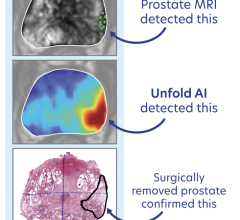
CTVPOST (red) = CTVPRE (yellow) union CTVPET (pink). Also shown (upper right corner) are the PRE (square) vs POST (triangle) dose volume histograms for PTV1, PTV2, rectum, bladder, and penile bulb, showing minimal impact on target coverage or organs at risk dose with the modified targets. Image courtesy of Ashesh B. Jani, M.D., and David Schuster, M.D., Emory University.
March 16, 2017 — The featured clinical investigation article of the March 2017 issue of the Journal of Nuclear Medicine demonstrates that the positron emission tomography (PET) radiotracer fluciclovine (fluorine-18; F-18) can help guide and monitor targeted treatment for recurrent prostate cancer, allowing for individualized, targeted therapy.
"This is the first study of its kind demonstrating changes in post-surgery radiotherapy target design with advanced molecular imaging in recurrent prostate cancer, with no demonstrated increase in early radiotherapy side effects," explained Ashesh B. Jani, M.D., of the Winship Cancer Institute of Emory University, Atlanta.
According to the American Cancer Society, one in seven men will develop prostate cancer in his lifetime. In 2017, more than 161,000 new diagnoses of prostate cancer are expected in the U.S., and about 26,730 deaths from the disease are anticipated.
For the study, 96 patients were enrolled in a clinical trial of radiotherapy for recurrent prostate cancer after prostatectomy. All patients underwent initial treatment planning based on results from conventional abdominopelvic imaging with computed tomography (CT) or magnetic resonance imaging (MRI). Forty-five of the patients then underwent treatment-planning modification (better defining the tumor-targeted area) after additionally undergoing abdominopelvic F-18-fluciclovine PET/CT. No increase in toxicity was observed with this process.
The Emory researchers determined that the inclusion of F-18-fluciclovine PET information in the treatment planning process leads to significant differences in target volumes. It did result in higher radiation dose delivered to the penile bulb, but no significant differences in bladder or rectal radiation dose, or in acute genitourinary or gastrointestinal toxicity.
These are preliminary results in a three-year study, which hypothesizes that there will be an increase in disease-free survival for patients in the F-18-fluciclovine-modified treatment group over those in the standard treatment group.
This study could have implications beyond prostate cancer, Jani pointed out. "Our methodology is readily applicable to other novel imaging agents, and it may potentially facilitate improvement of cancer control outcomes," he said.
Authors of the article "Impact of Fluciclovine (18F) PET on Target Volume Definition for Post-Prostatectomy Salvage Radiotherapy: Initial Findings from a Randomized Trial" include Jani, Eduard Schreibmann, Peter J. Rossi, Joseph Shelton, Karen Godette, Peter Nieh, Viraj A. Master, Omer Kucuk, Mark Goodman, Raghuveer Halkar, Sherrie Cooper, Zhengjia Chen, and David M. Schuster, Emory University, Atlanta, Georgia.
This research was sponsored by the National Institutes of Health (R01 CA169188) and Blue Earth Diagnostics Ltd.
For more information: www.jnm.snmjournals.org
References
Jani, A.B., Schreibmann, E., Rossi, P.J., Shelton, J., et al. "Impact of Fluciclovine (18F) PET on Target Volume Definition for Post-Prostatectomy Salvage Radiotherapy: Initial Findings from a Randomized Trial," Journal of Nuclear Medicine. Published online Sept. 8, 2016. DOI: 10.2967/jnumed.116.176057


 April 10, 2024
April 10, 2024 








